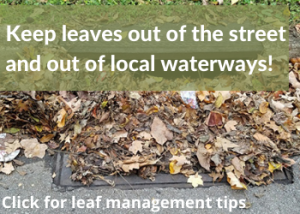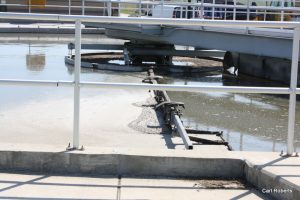
Solid objects are removed from the water as they settle to the bottom of the clarifier tank. Photo by Carl Roberts.
By Carl Roberts, EAC Volunteer
The Bloomington and Normal Water Reclamation District (BNWRD) has been cleaning the wastewater from the Twin Cities since 1919, when the residents of Bloomington and Normal voted to create a sanitary district. Working under the authority of a permit from the Illinois Environmental Protection Agency (EPA), the BNWRD is a completely local environmental agency dedicated to recycling wastewater safely, efficiently and economically.
In addition to operating sophisticated, conventional reclamation plants for the Twin Cities, the BNWRD has established two experimental wetlands. The wetlands are in an entirely natural environment in Randolph Township where nature cleans the impurities from wastewater without the need for equipment, power, chemicals or human intervention.
Sophisticated, conventional reclamation plants
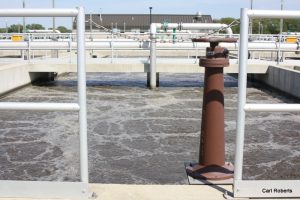
Microbes break down organic matter dissolved in the water. Photo by Carl Roberts.
Cleaning the wastewater from Bloomington-Normal is a tremendous undertaking. The BNWRD’s reclamation plants work day after day, all year long, to treat water through biological breakdown and filtration of pollutants. In an average day, 24.5 million gallons of wastewater – that’s nearly 200 gallons per person – are processed by the BNWRD.
The wastewater coming from the Twin Cities does not just contain food waste and human waste. It is also polluted with grit (dirt, sand and stones), paper products, cleaning agents, oils, paints and metals. All of these contaminants must be removed in order to provide clean water for drinking, farming and protecting the environment.
Wastewater from the sewers of the community is diverted into the reclamation plants, where it is first passed through screens that remove plastic and other foreign objects along with grit. The water is then processed naturally by microscopic organisms known as microbes. The microbes break down organic matter in the water, causing contaminants to settle on the bottom. The microbes also break down toxic substances such as nitrates, which are released into the atmosphere.
The water flows through settling tanks, where the microbes are extracted. The water is then run through a sand filter to remove any remaining contaminants, and it is finally disinfected by powerful ultraviolet lights before being released into Little Kickapoo Creek.
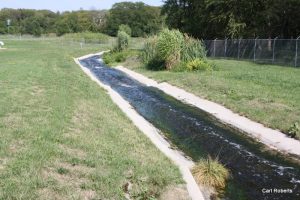
Clean water flows from the BNWRD plant into Little Kickapoo Creek. Photo by Carl Roberts.
Cleansing water naturally in the experimental wetlands
Wetlands provide an ecosystem where water is cleansed the way it is out in the wild. A wetland is an area that is immersed in water that contains considerable wild vegetation, waterfowl and animals.
When a stream of water runs through a wetland, contaminants are removed naturally. The bacteria turn nitrogen in the water into gas. Plants in a wetland absorb phosphorous from the water, to prevent the overfertilization of algae that make the water oxygen-deficient. This process is similar in many ways to the cleansing treatment water receives in a reclamation plant. The primary difference is that no machinery or people are needed. There is also no pollution or need for an external energy source.
The BNWRD has established two experimental wetland areas to see how effective they are in removing contaminants from water. Other benefits the wetlands provide include flood prevention, habitats for wildlife, hiking trails, and places to watch birds and animals.
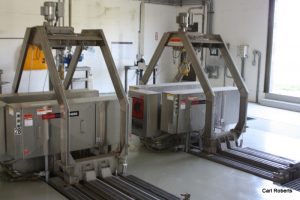
Water is disinfected by powerful ultraviolet lights before being released into Little Kickapoo Creek. Photo by Carl Roberts.
The experiment has shown mixed results so far. The larger wetland ecosystem is falling prey to gaggles of geese, while the smaller wetland ecosystem is prospering. The difference appears to be that the water in the small wetland freezes in the winter, which protects the plants. The larger wetland does not freeze, so the geese gather there and eat the roots of the plants.
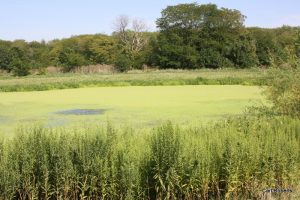
A layer of duck weed grows on the surface of the water in the wetland. Photo by Carl Roberts.
Shallow wetlands are being constructed as the next step in the experiment. They are only two or three inches deep, so the water will freeze quickly. It is anticipated that this will keep the geese away, protect the plants, and enable the wetlands to prosper.
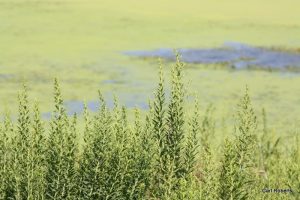
A variety of vegetation is plentiful in the wetland. Photo by Carl Roberts.




